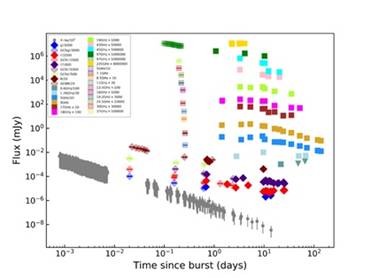Rebel behaviour of highest energy afterglow of a Gamma-Ray Burst detected in space may help probe stellar evolution

Figure 1: Multi-band lightcurves of the afterglow of GRB 190114C from X-ray to the radio/mm bands.
The highest energy afterglow detected in space so far seems to be a rebel. The emission from the most notable Gamma Ray Burst (GRB) explosion so far traced — the afterglow from a galaxy 4.5 billion light years away was found to be complex in nature and did not follow the evolution expected in standard afterglow models. The detection of high energy photons (TeV Photons) from this GRB provides new insights and important clues to unravel the underlying physical processes at work which result in such explosions.
The GRB with ultra-high energy photons called GRB 190114C was detected for the first time on 14-January-2019. This discovery was reported in Nature by the Major Atmospheric Gamma Imaging Cherenkov Telescopes (MAGIC) collaboration.
As usual, the GRB lasted for a brief period, followed by an initial bright flash in high energies known as the ‘prompt emission’. A less luminous but long-lasting counterpart known as the ‘afterglow’ was detected after the prompt emission and offered scientists the chance to probe the GRBs.
Dr. Kuntal Misra from Aryabhatta Research Institute of Observational Sciences (ARIES), Nainital, an autonomous institute of the Department of Science & Technology, along with significant contributions from national and international collaborators, carried out observations of the afterglow from GRB 190114C spanning over nearly 140 days after the burst. The paper has been published in Monthly Notices of the Royal Astronomical Society (MNRAS).
The optical observations of the afterglow from GRB 190114C were carried out with the Growth India Telescope (GIT), Himalayan Chandra Telescope (HCT) (both located in Hanle, Leh, India), and Devasthal Fast Optical Telescope (DFOT, located in Devasthal, Nainital, India) as well as with upgraded Giant Meter wave Radio Telescope (u-GMRT, located in Khodad, Pune, India), Australia Telescope Compact Array (ATCA, located in New South Wales, Australia) and the Atacama Large Millimeter Array (ALMA, located in Atacama Desert, Chile).
Detailed modelling of the afterglow using multi-band data indicates that the parameters describing the fraction of energy in electron population and magnetic field are evolving with time and not constant as generally seen in GRBs. The scientists suggested that the evolution of these parameters, at early times, may play a role in producing the bright TeV emission.
Figure 2: Left: GRB 190114C afterglow in the observer frame indicating it as one of the brightest known afterglows at early times. Right: Afterglows shifted to the z=1 frame indicating that the afterglow of GRB 190114C is of average nature at early times.
Figure 1 shows the multi-band light curves of the afterglow of GRB 190114C. The X-ray luminosity of the afterglow of GRB 190114C is similar to the majority of the GRB population. On the other hand, in optical bands, at early times, the afterglow of GRB 190114C is one of the brightest detected so far, observationally despite the high line-of-sight extinction. However, when the light curves are shifted to z=1 frame, GRB 190114C afterglow is seen to be of only average luminosity initially and mirroring the results found in X-rays (Figure 2).
Publication link: https://doi.org/10.1093/mnras/stab1050
For more details: Dr. Kuntal Misra (kuntal[at]aries.res.in).

